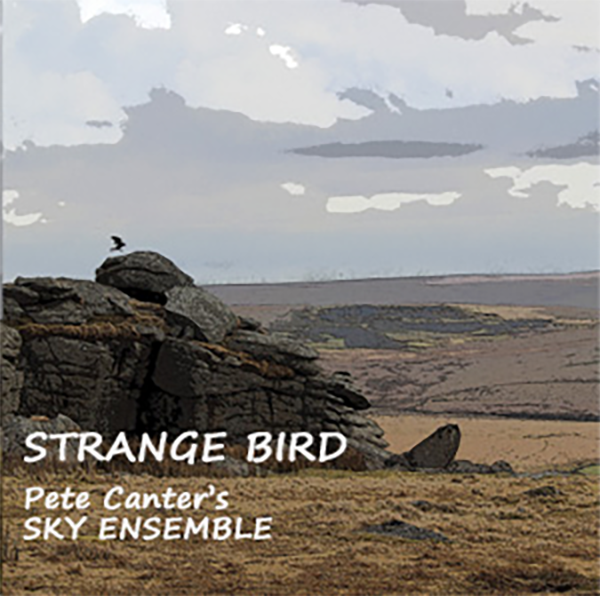
by Ian Mann
March 17, 2017
/ ALBUM
Canter has written a series of memorable melodic themes but the playing of this excellent quintet ensures that the music goes beyond mere prettiness.
Pete Canter’s Sky Ensemble
“Strange Bird”
(Self released)
In 2013 I reviewed “Lightflight”, an enjoyable quartet album featuring the writing and playing of the Exeter based saxophonist Pete Canter. “Lightflight” teamed Canter with three leading musicians from the Bristol jazz scene, pianist Jim Blomfield, bassist Sol Ahmed and drummer Mark Whitlam.
Canter plays tenor and soprano saxophones and since making his recording début in 1999 has released a number of albums, mainly in the classic jazz quartet format. His early output was largely concerned with the standards repertoire but since 2009’s “Ununbium”, a recording that also featured Blomfield, he has focussed exclusively on his own compositions and has emerged as a skilled and increasingly distinctive writer.
A glance at Canter’s website http://www.petecanter.com reveals that he performs as the leader of his own groups in quartet, trio and duo formats as well as being a member of the vocal jazz ensemble Art House Trio. He also organises events at Exeter’s popular Bridge Jazz Club. (http://www.bridgejazzclub.com
However Canter’s main current creative outlet is his new group Sky Ensemble which adds the distinctive sound of Lucy Welsman’s cello to a group also featuring the talents of pianist Matt Johns, bassist Jim Rintoul and “Ununbium” drummer Gary Evans. Sometimes the group is extended to a sextet with the addition of Iona Padel Collins on viola but it’s the five piece version of the band that appears on “Strange Bird” with Canter specialising exclusively on soprano saxophone.
The focus on the soprano plus the addition of Welsman’s cello ensures that Sky Ensemble sounds substantially different to Canter’s more straight-ahead jazz quartet. This group includes elements of folk, latin and classical music and approaches the music from a decidedly European perspective. The folk influence is particularly strong, and this, combined with the distinctive sound of Canter’s soprano sometimes reminded me of the music of Jan Garbarek, although given the West Country roots of this music perhaps the great John Surman might be a more appropriate parallel.
“Strange Bird” comprises of five new Canter compositions beginning with the title track which neatly encapsulates the various influences that inform the album as a whole. The folk like melody encourages Canter’s soprano to dance in suitably bird like fashion above the colours and textures generated by his colleagues. Welsman’s cello parts variously bring a refined, chamber like ambience while at other times producing a pipe like drone that underpins the solos of Canter and pianist Matt Johns. The pianist sparkles on his solos and his sound is well captured by engineer Duncan Chave who contributes a pinpoint mix. Welsman enjoys her moments in the spotlight as does bassist Rintoul who solos in succinct but melodic fashion and forms a flexible and intelligent rhythm team with drummer Evans.
At ten minutes plus “Air” is the lengthiest track on the album and once again the piece exemplifies all the virtues exhibited by its predecessor. Johns takes the first major solo and once more his playing is expansive and consistently inventive. He’s followed by the leader who probes subtly but incisively on soprano. Next we hear from Welsman, whose richly evocative cello brings such a distinctive sound to the group. Her dialogue with Canter is intelligently underscored by the other members of the group with Evans providing sharply detailed drum and cymbal commentary.
Cello, double bass and piano introduce “Sky” as folkish melodies combine with a ‘chamber jazz’ feel. However as the music gains momentum the style embraces something closer to modal jazz as Canter’s soprano sax takes flight. Welsman’s contributions mark her out as one of the UK’s leading cello improvisers, inviting favourable comparisons with London based musicians such as Ben Davis, Lucy Railton and Shirley Smart. Johns and Rintoul also impress with the fluency of their solos before the track ends as it began.
Rintoul’s unaccompanied bass introduces “Circle” which includes a lengthy theme statement and solo from Canter plus a well constructed solo drum feature from Evans. The excellent Johns also stretches out at length at the piano, subtly underscored by the timbres of Welsman’s cello.
Richly textured unaccompanied cello introduces the closing “Folk in Five” with its beguiling combination of folk melody and odd meter rhythm. Strong melodies and well balanced, high quality ensemble playing distinguish the album as a whole and this piece is no different. Canter’s sinuous soprano leads off the soloing and he’s succeeded by a melodic cameo from Rintoul and a more expansive offering from Johns that combines adventurousness with an underlying lyricism. The piece, and the album, conclude with a stirring sax and cello duo coda from Canter and Welsman.
“Strange Bird” expands upon the promise of “Lightflight” by creating a more distinctive group identity and putting the focus firmly on melody. Canter has written a series of memorable melodic themes but the playing of this excellent quintet ensures that the music goes beyond mere prettiness. There’s plenty going on within Canter’s compositions and both the ensemble playing and the soloing are bright and imaginative throughout with everybody, including engineer Chave, acquitting themselves superbly. I found myself enjoying this album more and more the longer I listened to it, which is always the best way.
blog comments powered by Disqus